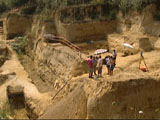


| Back |
The successive archaeological excavation campaigns at Veldwezelt-Hezerwater provided us with important lithic and faunal remains of at least five separate Middle Palaeolithic valley settlements. It is indeed remarkable to imagine that Middle Palaeolithic humans were extracting flint, were hunting animals, were collecting wood, were lighting fires, were reducing cores and were producing tools at this spot in the Hezerwater valley at different times during the Late Saalian (late MIS 6), the late Last Interglacial s.l. (MIS 5a) and the Middle Weichselian (MIS 3).
Middle Palaeolithic humans, who wanted to make a living at Veldwezelt-Hezerwater in a particular climatic setting, had to respond to that setting. This fact of course led to adaptation in terms of migrational, technological and "cultural" behaviour, which in turn affected their clothing, shelter, mobility, meat procurement and butchery methods and thus their lithic technology. We and others (e.g., Lévêque 1993; Bar-Yosef & Kuhn 1999; Clark 2002a,b; Jehs 2003, 2004) believe that human evolution is a relatively unimportant constraint on the character of core and tool reduction, being overridden in most contexts by mechanical constraints and economic and ecological processes. Furthermore, equifinality and formal convergence almost certainly overrides any hypothetical "cultural" component. Palaeolithic technology constituted a whole range of options, which were invoked differently according to context. These contextual factors and not "culture" constrained choice amongst these options (e.g., availability, size and quality of raw materials, mobility, anticipated tasks, etc.).
The cyclic appearance of parallel, centripetal (Levallois) core reduction, the presence of "typical", notched, denticulated, Quina or very small tools in the lithic assemblages at Middle Palaeolithic open-air sites in Northwest Europe should not be seen as extraordinary events, but simply as the natural outcome of the dynamics of flint knapping. Nor the cyclic "reinvention" of for instance laminar debitage, but the recognition of blades (etc.) as being more useful for certain kinds of activity in specific climatic settings, is a crucial element in the fluctuating technological process. Technological change is thus not the result of a linear evolution, but the outcome of isolated creative human actions. Many different elements must come together before triggering a technological shift: the element of resource availability and climate, the element of mobility and the element of culture innovation. We thus could put forward the hypothesis that, at least in temperate climatic conditions, Middle Palaeolithic humans could react instrumental in creating their own adequate life-sustaining technologies and this through interactions with the environment, changes in behaviour and modifications in their lithic technology. This approach considers Middle Palaeolithic humans as active agents, rather than passive recipients of optimised environmental conditions.
The "Veldwezelt-Hezerwater Project" has been made possible thanks to the generous support of all the scientific institutions involved. We especially would like to thank the Institute for the Archaeological Heritage (I.A.P.) of the Flemish Community, the Fund for Scientific Research - Flanders (F.W.O.) and the Provincial Gallo-Roman Museum Tongeren (Dir. Mrs. Carmen Willems, Con. Mr. Guido Creemers, Mr. Patrick Matheï & Mr. Bart Demarsin). We would also like to thank the Province of Limburg (Belgium), the Province of Limburg (The Netherlands), the Communities of Lanaken and Riemst and the City of Maastricht.
ANTOINE, P., ROUSSEAU, D.-D., LAUTRIDOU, J.-P. & HATTÉ, C. 1999. Last interglacial-glacial climatic cycle in loess-palaeosol successions in north-western France. Boreas 28, 4: 551-563.
BARTON, C.M. 1991. Retouched tools - fact or fiction? Paradigms for interpreting Paleolithic chipped stone. In: Clark, G.A. (ed.), Perspectives on the Past: Theoretical Biases in Mediterranean Hunter-Gatherer Research. Philadelphia: 143-163.
BAR-YOSEF, O. & KUHN, S.L. 1999. The big deal about blades: laminar technologies and human evolution. American Anthropologist 101: 322-338.
BAUMLER, M.F. 1988. Core reduction, flake production, and the Middle Paleolithic industry of Zobiste (Yugoslavia). In: Dibble, H.L. & Montet-White, A. (eds.), Upper Pleistocene Prehistory of Western Eurasia. University of Pennsylvania: The University Museum Monograph 54: 255-274.
BAUMLER, M.F. 1995. Principles and properties of lithic core reduction: implications for Levallois technology. In: Dibble, H.L. & Bar-Yosef, O. (eds.), The Definition and Interpretation of Levallois Technology. Madison: 11-23.
BIETTI, A., ROSSETTI, P. & ZANZI, G.-L. 1989. Cultural adaptations and environment: two test-cases from southern central Tyrrhenian Italy. Rivista di Antropologia 67: 239-264.
BOËDA, E. 1986. Approche technologique du concept Levallois et évolution de son champ d'application. Thèse de Doctorat de l'Université de Paris X. Paris.
BORDES, F. 1961. Mousterian Cultures in France. Science 134: 803-810.
BRANTINGHAM, P.J., OLSEN, J.W., RECH, J.A. & KRIVOSHAPKIN, A.I. 2000. Raw material quality and prepared core technologies in Northeast Asia. Journal of Archaeological Science 27: 525-571.
BRINGMANS, P.M.M.A. 2000. De Midden-Paleolithische bewoning van Veldwezelt-Hezerwater in een Noordwest-Europese context. Licence Dissertation. Leuven.
BRINGMANS, P.M.M.A. 2001. The Veldwezelt-Hezerwater Project (Belgium). Prehistoria 2000. Journal of the International Union for Prehistoric and Protohistoric Sciences U.I.S.P.P. 1, 1: 180.
BRINGMANS, P.M.M.A., VERMEERSCH, P.M., GROENENDIJK, A.J., MEIJS, E.P.M., DE WARRIMONT, J.-P. & GULLENTOPS, F. 2001. Preliminary Report on the excavations of the Middle Palaeolithic valley settlements at Veldwezelt-Hezerwater (Belgium). In: Bringmans, P.M.M.A. (ed.), XIVth Congress of the International Union of Prehistoric and Protohistoric Sciences - U.I.S.P.P. Member of the International Council for Philosophy and Human Studies U.N.E.S.C.O., 2 - 8 September 2001 Liège - Belgium. Stratigraphy and Prehistory of the River Maas Valley in Limburg - Belgium. Excursion Guide. Leuven: 21-29.
BRINGMANS, P.M.M.A., VERMEERSCH, P.M., GULLENTOPS, F., GROENENDIJK, A.J., MEIJS, E.P.M., DE WARRIMONT, J.-P. & CORDY, J.-M. 2002. Middle Palaeolithic Veldwezelt-Hezerwater One Year On. Interim Report on the Veldwezelt-Hezerwater Project's Campaign of Excavation 2002. In: Jehs, Dieter (ed.), Het Sleufje - Universiteit Gent - The Diggers' Project 8, 1B, 2: 1-15.
BRINGMANS, P.M.M.A., VERMEERSCH, P.M., GULLENTOPS, F., GROENENDIJK, A.J., MEIJS, E.P.M., DE WARRIMONT, J.-P. & CORDY, J.-M. 2003. Preliminary Excavation Report on the Middle Palaeolithic Valley Settlements at Veldwezelt-Hezerwater (prov. of Limburg). Archeologie in Vlaanderen - Archaeology in Flanders 1999/2000 VII: 9-30.
BRINGMANS, P.M.M.A., VERMEERSCH, P.M., GULLENTOPS, F., MEIJS, E.P.M., GROENENDIJK, A.J., DE WARRIMONT, J.-P. & CORDY, J.-M. 2004a. Middle Palaeolithic Veldwezelt-Hezerwater (Limburg, Belgium). Excursion Guide. Colloquium "Neanderthals in Europe". September 17-19, 2004. Provinciaal Gallo-Romeins Museum Tongeren. Leuven: 1-11.
BRINGMANS, P.M.M.A., VERMEERSCH, P.M., GULLENTOPS, F., GROENENDIJK, A.J., MEIJS, E.P.M., DE WARRIMONT, J.-P. & CORDY, J.-M. 2004b. The Veldwezelt-Hezerwater Project 2003. Final Campaign of Excavation. In Press.
BURDUKIEWICZ, J.M., SNIESZKO, Z. & WINNICKI, J. 1994. A Lower Palaeolithic settlement at Trzebnica (S.W. Poland). Ethnographisch-Archäologische Zeitschrift 34: 27-40.
CLARK, G.A. 2002a. Neanderthal Archaeology - implications for our origins. American Anthropologist 104, 1: 50-67.
CLARK, G.A. 2002b. Observations on paradigmatic bias in French and American Paleolithic Archaeology. In: Straus, L.G. (ed.), The Role of American Archeologists in the Study of the European Upper Paleolithic. BAR International Series 1048: 19-26.
CORDY, J.-M. 1988. Apport de la paléozoologie à la paléoécologie et à la chronostratigraphie en Europe du nord-occidental. In: L'Homme de Neandertal, 2, L'environnement, Etudes et Rercherches Archéologiques de l'Université de Liège (E.R.A.U.L.). Liège: 55-64.
CREW, H. 1975. An examination of the variability of the Levallois method: Its implications for the internal and external relationships of the Levantine Mousterian. Ph.D. Dissertation. Dept. of Anthropology, Southern Methodist University. Ann Arbor, MI: UMI.
DANSGAARD, W., JOHNSEN, S.J., CLAUSEN, H.B., DAHL-JENSEN, D., HAMMER, N. & OESCHGER, C.U. 1984. North Atlantic climate oscillations revealed by deep Greenland Ice Cores. In: Hansenand, J.E. & Takahashi, T. (eds.), Climate Processes and Climate Sensitivity. American Geophysical Union Geophysical Monograph 29: 288-298.
DANSGAARD, W., JOHNSEN, S.J., CLAUSEN, H.B., DAHL-JENSEN, D., GUNDESTRUP, N.S., HAMMER, C.U., HVIDBERG, C.S., STEFFENSEN, J.P., SVEINBJÖRNSDOTTIR, A.E., JOUZEL, J. & BOND, G. 1993. Evidence for General Instability of Past Climate from a 250-kyr Ice-core Record. Nature 364: 218-220.
DIBBLE, H. 1984. Interpreting typological variation of Middle Paleolithic scrapers: Function, style, or sequence of reduction? Journal of Field Archaeology 11: 431-436.
GAMBLE, C. 1986. The Palaeolithic Settlement of Europe. Cambridge.
GENESTE, J.-M. 1985. Analyse lithique d'industries moustériennes du Périgord: Une approche technologique du comportement des groupes humains au paléolithique moyen. Thèse de Doctorat de l'Université de Bordeaux I. Bordeaux.
GULLENTOPS, F. & MEIJS, E.P.M. 2002. Loess sequences in Northern Haspengouw, Belgian Limburg. In: Ikinger, A. & Schirmer, W. (eds.), Terra Nostra. Schriften der Alfred-Wegener-Stiftung 02/1. Loess units and solcomplexes in the Niederrhein and Maas area. Joint Symposium of the DEUQUA, BELQUA and Deutsche Bodenkundliche Gesellschaft / Arbeitskreis für Paläopedologie. Neuss, 09 - 12 Mai 2002. Department of Geology - Heinrich Heine University. Düsseldorf: 80-91.
GULLENTOPS, F., GROENENDIJK, A.J., MEIJS, E.P.M., MÜCHER, H.J., VERMEERSCH, P.M. & DE WARRIMONT, J.-P. 1998. Preliminary report of an exceptional catena of the Last Interglacial in the Loess Area of Belgian Limburg near Veldwezelt. INQUA-SEQS Symposium: The Eemian. Local Sequences, Global Perspectives. Excursion Guide. Kerkrade: 35-39.
GUTHRIE, R.D. 1984. Mosaics, allelochemics and nutrients: an ecological theory of Late Pleistocene megafaunal extinctions. In: Martin, P.S. & Klein, R.G. (eds.), Quaternary Extinctions: a Prehistoric Revolution. Tucson, Arizona: 259-298.
GUTHRIE, R.D. 1990. Frozen Fauna of the Mammoth Steppe. Chicago-London.
HEINRICH, H. 1988. Origin and consequences of cyclic ice rafting in the Northeast Atlantic Ocean during the past 130,000 Years. Quaternary Research 29: 142-152.
JEHS, D. 2003. De geest van de Neanderthaler. Een archeologische evaluatie van vijf cognitieve modellen. . Licence Dissertation. Gent.
JEHS, D. 2004. Gauging Neanderthal cognition: Problems and perspectives. In: Hoorne, J., Jehs, D. & Noens, G. (eds.), Ghent Archaeological Studies 1: 85-99.
LENOIR, M. 1973. Obtention expérimentale de la retouche de type Quina. Bulletin de la Société Préhistorique Française 70: 10-11.
LÉVÊQUE, F. 1993. The Castelperronian industry of Saint-Césaire: the upper level. In: Lévêque, F., Backer, A.M. & Guilbaud, M. (eds.), Context of a Late Neandertal: Implications of Multidisciplinary Research for the transition to Upper Paleolithic Adaptations at Saint-Césaire, Charente-Maritime, France. Monographs in World Archaeology: 16. 25-35.
MEIJS, E.P.M. 2002. Loess stratigraphy in Dutch and Belgian Limburg. Eiszeitalter und Gegenwart 51: 114-130.
MELLARS, P.A. 1996. The Neanderthal Legacy: An archaeological perspective from Western Europe. Princeton.
RÉVILLION, S., 1995. Technologie du débitage laminaire au Paléolithique moyen en Europe septentrionale: état de la question. Bulletin de la Société Préhistorique Française 92, 4: 425-441.
RÉVILLION, S. & TUFFREAU, A. (eds.), 1994. Les industries laminaires au Paléolithique moyen, Actes de la table ronde internationale organisée par l'ERA 37 du CRA-CNRS à Villeneuve-d'Ascq - 13 et 14 novembre 1991. Dossier de Documentation Archéologique 18. Paris: éditions CNRS.
SCHIRMER, W. 1999. Kaltzeiten und Warmzeiten im Löß. In: Becker-Haumann, R. & Frenchen, M. (eds.), Terrestrische Quartärgeologie. Köln: 81-100.
SCHIRMER, W. 2000. Rhein loess, ice cores and deep-sea cores during MIS 2-5. Zeitschrift der deutsche geologische Gesellschaft 151, 3: 309-332.
SCHIRMER, W. 2002. Compendium of the Rhein loess sequence. In: Ikinger, A. & Schirmer, W. (eds.), Terra Nostra. Schriften der Alfred-Wegener-Stiftung 02/1. Loess units and solcomplexes in the Niederrhein and Maas area. Joint Symposium of the DEUQUA, BELQUA and Deutsche Bodenkundliche Gesellschaft / Arbeitskreis für Paläopedologie. Neuss, 09 - 12 Mai 2002. Department of Geology - Heinrich Heine University. Düsseldorf: 8-23.
THIEME, H. 1997. Lower Palaeolithic hunting spears from Germany. Nature 385: 807-810.
TIXIER, J., INIZIAN, M.L. & ROCHE, H. 1980. Préhistoire de la pierre taillée, Vol. 1: Terminologie et technologie. Valbonne: CERP.
TURQ, A. 1989. Exploitation des matières premières lithiques et occupation du sol: l'exemple du Moustérien entre Dordogne et Lot. In: Laville, H. (ed.), Variations des Paléomilieux et Peuplement Préhistorique. Paris: 179-204.
TURQ, A. 1999. Reflections on the Middle Palaeolithic of the Aquitaine Basin. In: Roebroeks, W. & Gamble, C. (eds.), The Middle Palaeolithic Occupation of Europe. Leiden: 107-120.
VANMONTFORT, B., VERMEERSCH, P.M., GROENENDIJK, A.J., MEIJS, E.P.M., DE WARRIMONT, J.-P. & GULLENTOPS, F. 1998. The Middle Palaeolithic Site of Hezerwater at Veldwezelt, Belgian Limburg. Notae Praehistoricae 18: 5-11.
VAN PEER, P. 1992. The Levallois Reduction Strategy. Monographs in World Prehistory 13, Madison, WI.
VERMEERSCH, P.M. 2001. Middle Paleolithic Settlement Patterns in West European Open-Air Sites: Possibilities and Problems. In: Conard, N.J. (ed.), Settlement Dynamics of the Middle Paleolithic and Middle Stone Age. Tübingen: 395-417.
PATRICK M.M.A. BRINGMANS
PIERRE M. VERMEERSCH
FRANS GULLENTOPS
ERIK P.M. MEIJS,
ALBERT J. GROENENDIJK
JEAN-PIERRE DE WARRIMONT
Laboratorium voor Prehistorie
Katholieke Universiteit Leuven
Redingenstraat 16
3000 Leuven
Belgium
JEAN-MARIE CORDY
Ethologie et Psychologie Animales
Bât. L1 Inst. Physiologie L. Frédéricq
Université de Liège
Place Delcour 17
4020 Liège
Belgium


